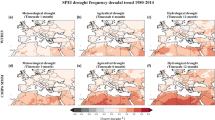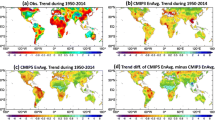Abstract
Both the attribution of historical change and future projections of droughts rely heavily on climate modeling. However, reasonable drought simulations have remained a challenge, and the related performances of the current state-of-the-art Coupled Model Intercomparison Project phase 6 (CMIP6) models remain unknown. Here, both the strengths and weaknesses of CMIP6 models in simulating droughts and corresponding hydrothermal conditions in drylands are assessed. While the general patterns of simulated meteorological elements in drylands resemble the observations, the annual precipitation is overestimated by ∼33% (with a model spread of 2.3%–77.2%), along with an underestimation of potential evapotranspiration (PET) by ∼32% (17.5%–17.2%). The water deficit condition, measured by the difference between precipitation and PET, is 50% (29.1%–71.7%) weaker than observations. The CMIP6 models show weaknesses in capturing the climate mean drought characteristics in drylands, particularly with the occurrence and duration largely underestimated in the hyperarid Afro-Asian areas. Nonetheless, the drought-associated meteorological anomalies, including reduced precipitation, warmer temperatures, higher evaporative demand, and increased water deficit conditions, are reasonably reproduced. The simulated magnitude of precipitation (water deficit) associated with dryland droughts is overestimated by 28% (24%) compared to observations. The observed increasing trends in drought fractional area, occurrence, and corresponding meteorological anomalies during 1980–2014 are reasonably reproduced. Still, the increase in drought characteristics, associated precipitation and water deficit are obviously underestimated after the late 1990s, especially for mild and moderate droughts, indicative of a weaker response of dryland drought changes to global warming in CMIP6 models. Our results suggest that it is imperative to employ bias correction approaches in drought-related studies over drylands by using CMIP6 outputs.
摘要
干旱变化的历史归因和未来预估依赖于气候模式。然而,可靠的干旱模拟仍是当前气候模拟研究领域面临的巨大挑战,第六次国际耦合模式比较计划(CMIP6)模式对干旱的模拟性能尚不清晰。鉴于此,本文系统评估了CMIP6模式在全球干旱区干旱事件和相应水热条件模拟方面的优缺点。研究表明,CMIP6模式可合理模拟出全球干旱区气象因子的空间分布特征。相较观测,模式模拟的年降水量气候态被高估约33% (模式间离差为2.3%–77.2%),年潜在蒸散发量(PET)则被低估约32% (17.5%–47.2%),进而导致水分亏缺程度(P–PET)被低估约50% (29.1%–71.7%)。CMIP6模式对旱区基本干旱特征的模拟能力仍有待提升,尤其亚非极端干旱区的干旱频率和持续时间被严重低估。但可以合理再现出干旱事件对应的水热条件异常,包括降水偏少、温度偏高、大气蒸发需求增大以及水分亏缺加剧,但模拟的降水和水分亏缺幅度分别被高估约28%和24%。CMIP6模式可合理模拟出干旱事件及相应的水热异常对气候增暖的响应特征,但响应偏弱,表现在明显低估了1990s后期干旱特征以及相应降水和水分亏缺的增加幅度。因此,利用CMIP6模式数据开展干旱区的干旱对生态环境的影响研究,与气象干旱有关的气象因子的偏差校正不可或缺。
Similar content being viewed by others
Explore related subjects
Discover the latest articles and news from researchers in related subjects, suggested using machine learning.References
Allen, R. G., L. S. Pereira, D. Raes, and M. Smith, 1998: Crop evapotranspiration—Guidelines for computing crop water requirements-FAO Irrigation and drainage paper 56. https://www.fao.org/3/X0490E/x0490e00.htm
Ault, T. R., 2020: On the essentials of drought in a changing climate. Science, 368, 256–260, https://doi.org/10.1126/science.aaz5492.
Cook, B. I., J. S. Mankin, K. Marvel, A. P. Williams, J. E. Smerdon, and K. J. Anchukaitis, 2020: Twenty-first century drought projections in the CMIP6 forcing scenarios. Earth’s Future, 8, e2019EF001461, https://doi.org/10.1029/2019EF001461.
Cherlet, M., Hutchinson, C., Reynolds, J., Hill, J., Sommer, S., von Maltitz, G. (Eds.), 2018: World Atlas of Desertification: Rethinking Land Degradation and Sustainable Land Management, Publication Office of the European Union, Luxembourg, https://doi.org/10.2760/9205.
Dai, A. G., 2011: Drought under global warming: A review. Advanced Review, 2, 45–65, https://doi.org/10.1002/wcc.81.
Davies, J., S. Barchiesi, C. J. Ogali, R. Welling, J. Dalton, and P. Laban, 2016: Water in Drylands: Adapting to Scarcity Through Integrated Management. IUCN.
Eyring, V., S. Bony, G. A. Meehl, C. A. Senior, B. Stevens, R. J. Stouffer, and K. E. Taylor, 2016: Overview of the coupled model intercomparison project phase 6 (CMIP6) experimental design and organization. Geoscientific Model Development, 9(5), 1937–1958, https://doi.org/10.5194/gmd-9-1937-2016.
Eyring, V., and Coauthors, 2019: Taking climate model evaluation to the next level. Nature Climate Change, 9, 102–110, https://doi.org/10.1038/s41558-018-0355-y.
Feng, S., and Q. Fu, 2013: Expansion of global drylands under a warming climate. Atmospheric Chemistry and Physics Discussions, 13, 14 637–14 665, https://doi.org/10.5194/acpd-13-14637-2013.
Gill, J. C., and B. D. Malamud, 2014: Reviewing and visualizing the interactions of natural hazards. Rev. Geophys., 52, 680–722, https://doi.org/10.1002/2013RG000445.
Harris, I., T. J. Osborn, P. Jones, and D. Lister, 2020: Version 4 of the CRU TS monthly high-resolution gridded multivariate climate dataset. Scientific Data, 7, 109, https://doi.org/10.1038/s41597-020-0453-3.
Huang, J. P., H. P. Yu, X. D. Guan, G. Y. Wang, and R. X. Guo, 2016: Accelerated dryland expansion under climate change. Nature Climate Change, 26, 166–171, https://doi.org/10.1038/NCLIMATE2837.
Hulme, M., 1996: Recent climatic change in the world’s drylands. Geophys. Res. Lett., 23, 61–64, https://doi.org/10.1029/95GL03586.
Kendall, M. G., 1955: Rank Correlation Methods. 2nd ed. C. Griffin, 86–91.
Liu, X. L., C. X. Li, T. B. Zhao, and L. Han, 2020: Future changes of global potential evapotranspiration simulated from CMIP5 to CMIP6 models. Atmospheric and Oceanic Science Letters, 13, 568–575, https://doi.org/10.1080/16742834.2020.1824983.
Mann, H. B., 1945: Non-parametric tests against trend. Econometrica, 13, 245–259, https://doi.org/10.2307/1907187.
Middleton, N., and D. Thomas, 1992: World Atlas of Desertification. UNEP.
Monteith, J. L., 1965: Evaporation and Environment. Symposia of the Society for Experimental Biology, 19, 205–234.
Penman, H. L., 1948: Natural evaporation from open water, bare soil and grass. Proceedings of the Royal Society A: Mathematical, Physical and Engineering Sciences, 193, 120–145, https://doi.org/10.1098/rspa.1948.0037.
Peters-Lidard, C. D., D. M. Mocko, L. Su, D. P. Lettenmaier, P. Gentine, and M. Barlage, 2021: Advances in land surface models and indicators for drought monitoring and prediction. Bull. Amer. Meteor. Soc., 102, E1099–E1122, https://doi.org/10.1175/BAMS-D-20-0087.1.
Piao, S. L., X. P. Zhang, A. P. Chen, Q. Liu, X. Lian, X. H. Wang, S. S. Peng, and X. C. Wu, 2019: The impacts of climate extremes on the terrestrial carbon cycle: a review. Science China Earth Sciences, 62, 1551–1563, https://doi.org/10.1007/s11430-018-9363-5.
Sen, P. K., 1968: Estimates of the regression coefficient based on Kendall’s Tau. Journal of the American Statistical Association, 62, 1379–1389, https://doi.org/10.1080/01621459.1968.10480934.
Seo, K. H., J. Ok, J. H. Son, and D. H. Cha, 2013: Assessing future changes in the East Asian summer monsoon using CMIP5 coupled models. J. Climate, 26, 7662–7675, https://doi.org/10.1175/JCLI-D-12-00694.1.
Sherwood, S., and Q. Fu, 2014: A drier future? Global warming is likely to lead to overall drying of land surfaces Science, 343, 737–739, https://doi.org/10.1126/science.1247620.
Sivakumar, M. V. K., R. Lal, R. Selvaraju, and I. Hamdan, 2013: Climate Change and Food Security in West Asia and North Africa. Springer, https://doi.org/10.1007/978-94-007-6751-5.
Theil, H., 1992: A rank-invariant method of linear and polynomial regression analysis. Henri Theil’s Contributions to Economics and Econometrics, B. Raj and J. Koerts, Eds., Springer, 345–381, https://doi.org/10.1007/978-94-011-2546-8.
Ukkola, A. M., A. J. Pitman, M. G. De Kauwe, G. Abramowitz, N. Herger, J. P. Evans, and M. Decker, 2018: Evaluating CMIP5 model agreement for multiple drought metrics. Journal of Hydrometeorology, 19, 969–988, https://doi.org/10.1175/JHM-D-17-0099.1.
Ukkola, A. M., M. G. De Kauwe, M. L. Roderick, G. Abramowitz, and A. J. Pitman, 2020: Robust future changes in meteorological drought in CMIP6 projections despite uncertainty in precipitation. Geophys. Res. Lett., 47, e2020GL087820, https://doi.org/10.1029/2020GL087820.
Vicente-Serrano, S. M., S. Beguería, and J. I. López-Moreno, 2010: A multiscalar drought index sensitive to global warming: The standardized precipitation evapotranspiration index. J. Climate, 23, 1696–1718, https://doi.org/10.1175/2009JCLI2909.1.
Vicente-Serrano, S. M., and Coauthors, 2013: Response of vegetation to drought time-scales across global land biomes. Proceedings of the National Academy of Sciences of the United States of America, 110, 52–57, https://doi.org/10.1073/pnas.1207068110.
Vicente-Serrano, S. M., S. M. Quiring, M. Peña-Gallardo, S. S. Yuan, and F. Domínguez-Castro, 2020: A review of environmental droughts: Increased risk under global warming. Earth-Science Reviews, 201, 102953, https://doi.org/10.1016/j.earscirev.2019.102953.
White, R. P., and J. Nackoney, 2003: Drylands, People, and Ecosystem Goods and Services: A Web-Based Geospatial Analysis. World Resources Institute.
WMO, 2021: WMO Atlas of Mortality and Economic Losses from Weather, Climate and Water Extremes (1970–2019). WMO.
Zhao, T. B., and A. G. Dai, 2017: Uncertainties in historical changes and future projections of drought. Part II: Model-simulated historical and future drought changes. Climatic Change, 144, 535–548, https://doi.org/10.1007/s10584-016-1742-x.
Zhao, T. B., and A. G. Dai, 2022: CMIP6 model-projected hydroclimatic and drought changes and their causes in the twenty-first century. J. Climate, 35, 897–921, https://doi.org/10.1175/JCLI-D-21-0442.1.
Zhao, T. B., L. Chen, and Z. G. Ma, 2014: Simulation of historical and projected climate change in arid and semiarid areas by CMIP5 models. Chinese Science Bulletin, 59, 412–429, https://doi.org/10.1007/s11434-013-0003-x.
Acknowledgements
This work is supported by Ministry of Science and Technology of China (Grant No. 2018YFA0606501), National Natural Science Foundation of China (Grant No. 42075037) and Key Laboratory Open Research Program of Xinjiang Science and Technology Department (Grant No. 2022D04009), and the National Key Scientific and Technological Infrastructure project “Earth System Numerical Simulation Facility” (EarthLab). The CRU TS v.4.03 can be obtained from https://crudata.uea.ac.uk/cru/data/hrg/. The SPEI database v2.6 is available at https://spei.csic.es/database.html. The CMIP6 simulations can be found at https://esgf-node.llnl.gov/search/cmip6/.
Author information
Authors and Affiliations
Corresponding author
Additional information
Article Highlights
• The water deficit condition over drylands in CMIP6 models is weaker than observations due to overestimated climate mean precipitation and underestimated PET.
• CMIP6 models overestimate drought intensity but underestimate drought occurrence and duration in drylands, which may result from more severe water deficits during droughts.
• The observed increasing trends of dryland droughts and contributions of precipitation and PET are well simulated by CMIP6, albeit with a weaker response to global warming after the 1990s than observations.
This paper is a contribution to the special issue on Causes, Impacts, and Predictability of Droughts for the Past, Present, and Future.
Rights and permissions
About this article
Cite this article
Yu, X., Zhang, L., Zhou, T. et al. Assessing the Performance of CMIP6 Models in Simulating Droughts across Global Drylands. Adv. Atmos. Sci. 41, 193–208 (2024). https://doi.org/10.1007/s00376-023-2278-4
Received:
Revised:
Accepted:
Published:
Issue Date:
DOI: https://doi.org/10.1007/s00376-023-2278-4




